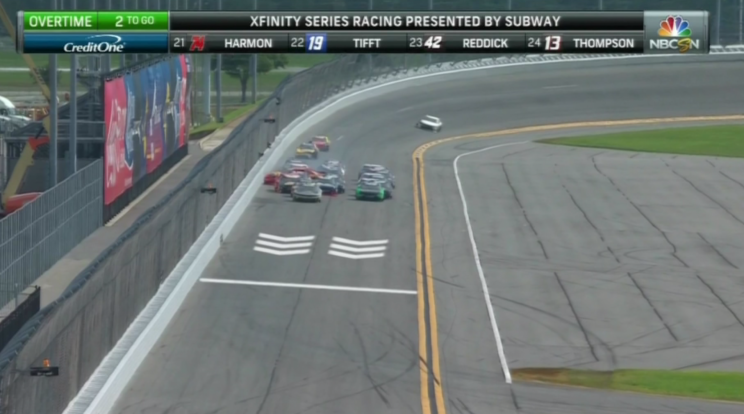The overtime line strikes: Daytona Xfinity race ends on controversial NASCAR caution call

The rules regarding NASCAR’s overtime line are pretty simple. If a caution comes out when the race leader is past the overtime line on the next-to-last lap of the race on a green-white-checker restart, the race is over.
The execution regarding the overtime line is proving to be incredibly complicated.
William Byron was declared the winner of Saturday’s rain-delayed Xfinity Series race at Daytona because NASCAR threw a caution for a wreck on the backstretch on the penultimate lap of the race.
Byron, by the rules listed above, was past the overtime line when the caution was called. But the accident that caused the caution happened well before the overtime line. And it wasn’t even close. Take a closer look at this picture from above:

Here’s what it looked like in real time. You can see that about two seconds elapse from the moment of the crash to when Byron gets to the OT line.

The issue, obviously, is the delay from when an accident happens to when NASCAR throws a caution flag. Officials in the scoring tower can’t always press a button immediately when a car hits the wall. Inevitably, as it always is with human nature, there’s a lag of a second or two before the caution lights come on a the track to tell drivers and teams that a caution has been displayed.
Those caution lights are the official determination of who wins or loses a race. This race a year ago was decided at the time of the caution lights. Aric Almirola won as his car was inches ahead of Justin Allgaier’s when the yellow light came on.
And earlier this year in the Truck Series, Christopher Bell was inches ahead of Chase Briscoe at Texas when a caution was called as the two drivers had just started their final lap.
In those instances, NASCAR went to video replay to determine the exact moment of caution. Video replay should have been used on Saturday. It wasn’t.
After the overtime came into play at the finish of the Cup Series race at Dover in June, NASCAR Vice President of Competition Scott Miller said the following day on SiriusXM that the rule was “black and white” and “straightforward.” On Saturday, the officiating seemed a red and green maze — the antithesis of something straightforward and black and white.
Had NASCAR used video replay to determine when the accident happened and saw that Byron wasn’t even close to the overtime line, the race would have been restarted again per the NASCAR rule book. It would have been a black-and-white example of officiating a “straightforward” rule.
Instead, NASCAR didn’t look at the video replay. Or if it did, it clearly thought the images were fake news. And in doing so, it opened itself up to a ton of criticism about creative enforcement of rules that are purportedly so cut and dry.
That criticism is deserved. The delay between the crash and the caution call potentially changed the outcome of the race. Byron could have held on and won on the next restart, but we don’t know that for sure.
That what-if is why it’s imperative for NASCAR to get calls like this right. Not what it just deems correct. There’s no need for a line painted on the track to become anything resembling a judgment call.
The overtime line was installed before the 2016 season after a wreck-fest that ended the 2015 Cup Series fall race at Talladega. It was a novel concept with rules that made sense on the surface. But NASCAR’s execution and reluctance to use video replay like it does in other race-winning moments isn’t straightforward.
It’s time for the overtime line to go. And NASCAR’s officiating is the sole reason why.
– – – – – – –
Nick Bromberg is the editor of Dr. Saturday and From the Marbles on Yahoo Sports. Have a tip? Email him at nickbromberg@yahoo.com or follow him on Twitter!
More NASCAR coverage on Yahoo Sports:



